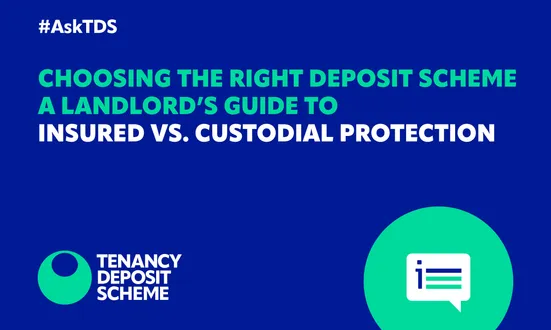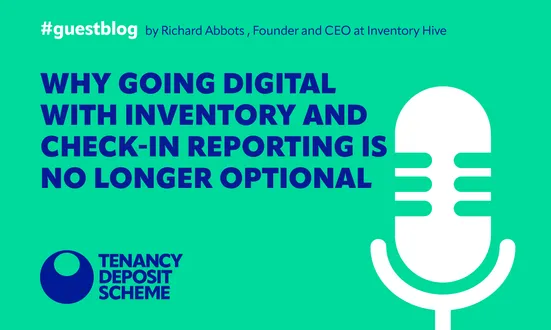The end of the academic year can be a hectic time for student landlords and letting agents. If you want to minimise disputes, protect your property, and keep your student tenants happy, a proactive, well-managed check-out process is essential. In this weeks #ASKTDS, the Tenancy Deposit Scheme explains how to streamline student check-outs and avoid common pitfalls, while ensuring your next tenants move in with everything in top shape.
Start early: The six-week countdown
Successful check-outs begin long before moving day. Around six weeks before the end of the tenancy, reach out to your tenants with a friendly email confirming the contractual move-out date. Politely ask them to confirm their departure day and time so you’re not left hunting for keys hidden under flowerpots. Early communication reduces uncertainty and makes everything else run easier.
When you get in touch, attach the original check-in inventory, outline cleaning expectations, and remind tenants that rent must be paid up until the final day. Importantly, remember to clarify that the deposit cannot be used as last month’s rent, a common source of confusion for students. Including a simple, friendly checklist (empty fridges, wipe ovens, remove Blu-Tack) often prevents bigger issues from developing and reassures tenants that you’re there to help.
Book a pre-move-out inspection
About two to three weeks before tenants are due to leave, arrange a pre-check-out inspection with at least one tenant present. This is your opportunity to flag anything that can be easily remedied, like limescale on taps, missing light bulbs, or scuffmarks on paint. Walk through each room with the original inventory and compare the current state, highlighting out any potential deductions.
Take clear, date-stamped photographs of issues and email a summary the same day. This written record reduces surprises during the final inspection and gives tenants the chance to address problems themselves. Most deposit disputes stem from tenants being surprised at check-out, therefore a pre-inspection helps avoid this.
Provide a clear cleaning & rubbish plan
Cleaning is the number one cause of end-of-tenancy disagreements, especially in student properties. Supply tenants with a realistic cleaning checklist that focuses on the key areas, and encourage tenants to pay extra attention to commonly missed areas such as extractor fans, ovens, behind and under appliances, as they are commonly missed spots.
Don’t forget about rubbish removal
Remind tenants of bin collection days during their final week, and warn them that overflowing bins can delay new photos or the next move-in. Some landlords recommend professional cleaning services at a cost if needed, however, you cannot require tenants to pay for a professional clean unless the property is not returned to the same standard as at check-in.
Any deductions for cleaning must be supported by evidence and agreed in writing, and only taken from the deposit after check-out, not as an up-front fee.
Get your check-out toolkit ready
Being organised on check-out day saves time and prevents disputes. Key items you’ll need could include:
- The original, signed inventory (your primary evidence for any deposit deductions)
- Spare batteries or light bulbs (tenants can swap these out immediately)
- A camera or smartphone with date stamps for documenting the property’s condition
- A meter-reading sheet
- A key-return envelope for counting and labelling each set. Missing keys are a legitimate reason for a deduction, so be thorough.
Conduct the formal check-out
Arrange the final check-out for the day the last tenant moves out, not after contractors have visited. Walk room by room with the inventory, noting cleanliness, condition, and any missing items. Take final meter readings (and photographs for proof), and collect all keys including those for bedrooms, desk drawers, and window locks. At the end of the process, have the tenants sign the check-out report.
Handle deposit deductions quickly and transparently
Transparency is key when it comes to deposit deductions. Calculate any proposed deductions within ten days, and back up claims with invoices or written quotes. Adjudicators will expect evidence to back up the deductions, not rough estimates. If you collected individual deposits, break costs down by person. For joint deposits, show the group total and allow housemates to allocate shares between themselves. You’ll be able to use TDS’s self-resolution portal to request deductions, discuss and negotiate any proposed charges directly with your tenants, upload supporting evidence, or return the deposit in full if there are no disputes.
Reletting the property
A smooth check-out means you can re-let the property faster. Schedule core maintenance tasks in a logical order, like tradespeople first, decorators, then a professional cleaning team, and finally photographers for marketing materials and viewings. Summer is peak season for contractors, so book them as soon as your tenants confirm their move-out dates.
Take advantage of the empty period to update compliance paperwork. If a gas safety certificate is due within the next two months, bring it forward. Test and replace any faulty smoke or carbon monoxide alarms now. Once the deep clean is finished, update your marketing photos and list the property early. The faster you act, the less chance you’ll face a void.
Stay legally compliant
Legislation affecting student lets is continually evolving, so it’s vital to stay up to date. The deposit cap remains at five weeks’ rent for most Assured Shorthold Tenancies (ASTs). As of June 2025, Section 21 “no-fault” evictions are still permitted, but the proposed Renters (Rights) Bill will bring significant changes in the near future.
The Renters (Rights) Bill, is likely to abolish Section 21 notices entirely and introduce new rules for periodic tenancies, potentially affecting the flexibility of fixed-term student lets. It may also increase notice requirements and strengthen tenant protections. While the details are still making their way through Government, it’s important to follow updates and prepare for possible changes to your processes.
For Houses in Multiple Occupation (HMOs), keep a close eye on local council requirements around minimum room sizes and waste-storage facilities. Licence conditions can change at renewal, so always double-check to ensure compliance.
Since October 2022, landlords have been required to repair or replace faulty smoke and carbon monoxide alarms “as soon as practicable.” Test all alarms on move-in day, record the results, and respond quickly to any reported issues.
For more guidance, visit our TDS Help Centre to find more guides, tools and templates, all designed to make your life easier. And remember to keep your procedures under review as legislation evolves, especially when the Renters (Rights) Bill becomes law.
Good luck with this year’s check-outs!
About TDS
The Tenancy Deposit Scheme is part of The Dispute Service (TDS), the largest tenancy deposit protection and resolution service provider in the UK making life easier for tens of thousands of agents, landlords, developers, and millions of tenants and homebuyers.
Our award-winning customer service is highly rated on both Trustpilot and Google, and we’re backed by the NRLA.
We offer free deposit protection in our Custodial scheme, and the lowest rates for landlords in our Insured scheme.
Other news stories


